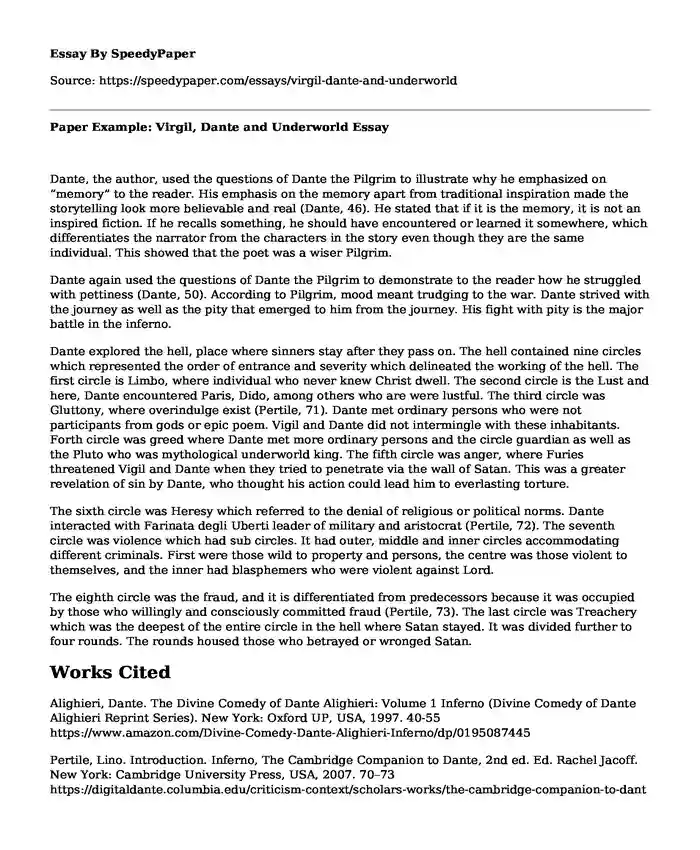
| Essay type: | Book review |
| Categories: | Analysis Writers World literature |
| Pages: | 2 |
| Wordcount: | 488 words |
Dante, the author, used the questions of Dante the Pilgrim to illustrate why he emphasized on “memory” to the reader. His emphasis on the memory apart from traditional inspiration made the storytelling look more believable and real (Dante, 46). He stated that if it is the memory, it is not an inspired fiction. If he recalls something, he should have encountered or learned it somewhere, which differentiates the narrator from the characters in the story even though they are the same individual. This showed that the poet was a wiser Pilgrim.
Dante again used the questions of Dante the Pilgrim to demonstrate to the reader how he struggled with pettiness (Dante, 50). According to Pilgrim, mood meant trudging to the war. Dante strived with the journey as well as the pity that emerged to him from the journey. His fight with pity is the major battle in the inferno.
Dante explored the hell, place where sinners stay after they pass on. The hell contained nine circles which represented the order of entrance and severity which delineated the working of the hell. The first circle is Limbo, where individual who never knew Christ dwell. The second circle is the Lust and here, Dante encountered Paris, Dido, among others who are were lustful. The third circle was Gluttony, where overindulge exist (Pertile, 71). Dante met ordinary persons who were not participants from gods or epic poem. Vigil and Dante did not intermingle with these inhabitants. Forth circle was greed where Dante met more ordinary persons and the circle guardian as well as the Pluto who was mythological underworld king. The fifth circle was anger, where Furies threatened Vigil and Dante when they tried to penetrate via the wall of Satan. This was a greater revelation of sin by Dante, who thought his action could lead him to everlasting torture.
The sixth circle was Heresy which referred to the denial of religious or political norms. Dante interacted with Farinata degli Uberti leader of military and aristocrat (Pertile, 72). The seventh circle was violence which had sub circles. It had outer, middle and inner circles accommodating different criminals. First were those wild to property and persons, the centre was those violent to themselves, and the inner had blasphemers who were violent against Lord.
The eighth circle was the fraud, and it is differentiated from predecessors because it was occupied by those who willingly and consciously committed fraud (Pertile, 73). The last circle was Treachery which was the deepest of the entire circle in the hell where Satan stayed. It was divided further to four rounds. The rounds housed those who betrayed or wronged Satan.
Works Cited
Alighieri, Dante. The Divine Comedy of Dante Alighieri: Volume 1 Inferno (Divine Comedy of Dante Alighieri Reprint Series). New York: Oxford UP, USA, 1997. 40-55 https://www.amazon.com/Divine-Comedy-Dante-Alighieri-Inferno/dp/0195087445
Pertile, Lino. Introduction. Inferno, The Cambridge Companion to Dante, 2nd ed. Ed. Rachel Jacoff. New York: Cambridge University Press, USA, 2007. 70–73 https://digitaldante.columbia.edu/criticism-context/scholars-works/the-cambridge-companion-to-dante/
Cite this page
Paper Example: Virgil, Dante and Underworld. (2023, Aug 28). Retrieved from https://speedypaper.net/essays/virgil-dante-and-underworld
Request Removal
If you are the original author of this essay and no longer wish to have it published on the SpeedyPaper website, please click below to request its removal:
- Personal Experience Essay - Starting Local, but Moving Global. Free Example
- Essay Sample on Andrew Johnson's Tragic Flaw
- Literary Essay Sample: Themes of The Great Gatsby, Of Mice and Men, and To Kill a Mockingbird
- Free Essay. Innovation and Entrepreneurship- N. Blumenthal, D. Gilboa, A. Hunt, and J. Raider
- Free Essay: Listing Prada on Hong Kong
- Essay Example: Henrico Retail Inc.
- The Boat People: Literary Analysis Essay Sample
Popular categories




